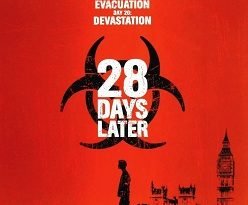28 Years Later: Mark Kermode’s horror movie review (video).
The Rage Virus is back, muses our man-of-many-movies, Mark Kermode. Not a gentle comeback, mind you—not like an old ex suddenly texting you at 3 a.m. No, this is more like that same ex crashing through your front door with a flaming machete and a hundred infected friends in tow. Yes, 28 Years Later has finally arrived, and it’s been worth every single fevered, post-apocalyptic moment of the wait.
Danny Boyle, Alex Garland and cinematographer Anthony Dod Mantle—the original dream team who traumatised a generation with 2002’s 28 Days Later—have returned to bring us a horror sequel that’s less about survival and more about what’s left to survive for. Oh, and it’s not alone. It was filmed back-to-back with a sequel (28 Years Later: The Bone Temple) because when you’ve opened the Pandora’s box of viral ultraviolence, you might as well pour yourself a cuppa and stay a while.
This latest entry picks up, appropriately enough, in the decaying twilight of Britain’s eternal quarantine. Europe’s moved on, bless them. Britain? Not so much. It’s the year 2030, and on Lindisfarne—yes, the Holy Island itself—we meet Spike, a boy in the ruins of a crumbling society, his scavenger dad Jamie, his terminally ill mum Isla, and a whole mess of regrets, secrets, and infected nasties with upgraded IQs and dental plans. These new “Alphas” aren’t your average slavering zombies—they’re smart, they’re strong, and they’ve clearly been reading Sun Tzu between mutilations.
There’s a strange poetry to all of this, quite literally. The trailer’s use of Rudyard Kipling’s “Boots,” recited in haunting tones by Taylor Holmes, sets the tone for a film that manages to blend the operatic with the utterly unhinged. At one point we even get a bone temple. Yes, really. A shrine made of skulls and femurs, lovingly curated by Ralph Fiennes as a reclusive doctor who’s halfway between Dr. Frankenstein and an oddly charming cemetery tour guide.
Infectious gore aside, the cast does wonders with the nightmare. Jodie Comer brings aching vulnerability and ferocity, Aaron Taylor-Johnson does a solid turn as an emotionally absent dad you wouldn’t trust with a microwave meal, and newcomer Alfie Williams anchors it all with a quietly affecting performance as young Spike. Toss in a NATO soldier played by Edvin Ryding, who gets decapitated by an Alpha while trying to off a Rage Baby™ (yes, that happens), and you’ve got yourself one hell of a trauma buffet.
Boyle’s decision to shoot the film largely on iPhone 15s (because why not add that to the chaos) means everything looks strangely real and sweaty—as if the whole thing might lunge out of the screen at any moment and bite your nose off. It’s a nostalgic nod to the digital grime of the original 28 Days Later, only now with higher resolution and, presumably, better facial recognition for the infected.
And because this is the era of the cinematic cult leader, enter Jack O’Connell as Sir Jimmy Crystal: charismatic, dangerous, and absolutely surrounded by devoted nutters named Jimmy. There’s Jimmy Ink, Jimmy Snake, Jimmy Jimmy, and—our personal favourite—Jimmy Shite. It’s as though someone took the worst Glastonbury afterparty and crossed it with The Wicker Man.
Critics have, understandably, lost their minds (and possibly their entrails) over this one. Five-star reviews are raining down like Alpha blood spatters, with many praising it as Boyle’s best since Slumdog Millionaire, though with more cannibalism and fewer Bollywood dance numbers. Rolling Stone pondered whether it holds together as a whole, but even their hesitation couldn’t obscure the film’s sheer visceral brilliance.
Here at SFcrowsnest, we do love a good zombie romp, especially one that doesn’t so much raise the bar as impale it on a sharpened bone and hurl it into the sea. With 28 Years Later, Boyle and Garland have done the impossible: crafted a third entry in a decades-old horror franchise that feels fresh, frightening, and—dare we say it—oddly beautiful in its own grotesque way.
And with The Bone Temple shuffling menacingly around the corner for 2026, we’ve not seen the last of the Rage. If this film taught us anything, it’s that trauma is hereditary, redemption is fleeting, and the Jimmy Cult probably has a really good theme song.




